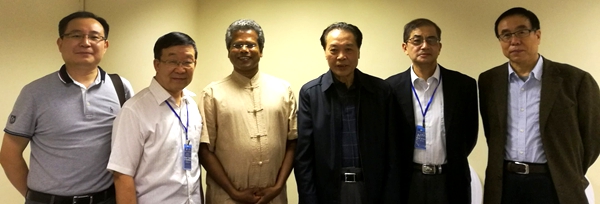Lotus Tower shows cultural ties between Sri Lanka, China
 0 Comment(s)
0 Comment(s) Print
Print E-mail China.org.cn, December 06, 2017
E-mail China.org.cn, December 06, 2017
Patrick Mendis, a professor at the Harvard University, told an international audience of scholars that his birthplace of Polonnaruwa had enjoyed a long history of Buddhist, diplomatic and commercial relations between the Sri Lankan kingdoms and successive Chinese Dynasties from Xi'an to Nanjing and beyond.

According to the Harvard professor, throughout the dynasties of King Parakramabahu the Great of the Polonnaruwa Kingdom and the Yapahuwa, Dambadeniya and Kotte Kingdoms, mutual bilateral trade relations existed with China. During the Polonnaruwa period, for example, Sri Lanka exported rice to China and imported silk and ceramic products. Ironically, post-colonial Sri Lanka has had to import rice from China in exchange for natural rubber under the Sino-Sri Lanka Rice-Rubber Agreement.
Professor Mendis is a sinologist and a Confucian scholar at the China National Confucius Research Institute in Qufu, birthplace of Confucius. He is currently serving as a Research Associate at the world-renowned Fairbank Center for Chinese Studies at Harvard University, as well as being a distinguished visiting professor of Asian-Pacific affairs at Shandong University in Jinan. A senior fellow and academic advisor to the Pangoal Institution in Beijing, Professor Mendis has lectured at over 25 Chinese universities in Beijing, Hefei, Guangzhou, Nanjing, Shanghai, Wuhan, and several other cities.
The International Confucianism Forum, held at Colombo, Sri Lanka, was sponsored by the International Confucian Association (ICA) in Beijing and the University of Kelaniya in Sri Lanka. The Honorable Karu Jayasuriya, the speaker of the Sri Lankan Parliament, was chief guest. Professor Mendis is a member of the ICA appointed by its President, Teng Wensheng, who welcomed more than 100 delegates from Africa, East Asia, Southeast Asia, the Middle East, and other regions.

Speaking of Chinese President Xi Jinping's Belt and Road Initiative (BRI) and its influence on Sri Lanka, Professor Mendis said, "The rising Colombo Lotus Tower in the Beira Lake is the modern manifestation of the earliest and continued Sino-Lanka dialogue between the Theravada and Mahayana Buddhism of the Abayagiri and Mahavihara traditions in the Anuradhapura and Polonnaruwa Kingdoms and visiting Chinese Buddhist pilgrims during the Jin, Song, Tang, Ming, and Qing dynasties of China." The BRI has combined the legacy of the ancient Silk Road of China in the Tang Dynasty and the advancement of maritime technology in the Ming Dynasty illustrated by Chinese diplomat Zheng He, who visited Sri Lanka while voyaging.
Ten centuries before the Ming envoy, the famous Chinese pilgrim, the eminent Chinese monk Faxian arrived in Sri Lanka in the 5th Century to learn more about the Pali Tripitaka and Buddhist discourses, Professor Mendis explained. The Chinese emperors and frequent travelers since the Han Dynasty maintained cordial and friendly relations with what Faxian called the "Buddhist Kingdom of the Lion," he added.
Even in the centuries before the Han Dynasty, ancient Chinese knew the reputation of the island as the most important sanctuary and center of Buddhist learning, what Faxian later described as "Dharmadeepa", a splendid island of Buddhist teachings.
While the Buddhist Kingdom has long been associated with the symbol of the lion from the Kingdom of Vijaya, ancient China was widely known as the "land of the dragon" before the Han Dynasty. Buddhism was the bonding of the millennia-old association between the "lion" and the "dragon", making them inseparable partners in spiritual development, said Professor Mendis.
The evolving Sino-Lanka history is critically important for a deeper understanding of the Colombo Lotus Tower, the professor explained. Above all, the most significant is the threefold Lotus Sutra. It consists of the Samanthabhadra Meditation Sutra, translated into Chinese by the eminent monk Dharmaraksa of Dunhuang, an early translator of Mahayana sutras into Chinese, during the Western Jin Dynasty. The Lotus Sutra and the Vimuttimagga Sutra in the Mahayana traditions played a transformative role in the development of Chinese Buddhism.
The sacred Sri Pada (Adam's Peak) mountain in Sri Lanka and the holy mountain of Emei in China (Sichuan Province) have been sharing the God Saman as patron in reverence of the Samanthabadra Sutra for Universal Virtues, explained Professor Mendis. He then concluded that the Colombo Lotus Tower is associated with the threefold Lotus Sutra to signify the heritage of Sino-Lanka Buddhist discourse.
Award-winning American diplomat and a military professor in the NATO and Pacific Commands, Dr. Mendis is the author of "Peaceful War: How the Chinese Dream and American Destiny Create a Pacific New World Order" (also translated into Chinese). He serves as a Commissioner of the U.S. National Commission for UNESCO, an appointment of the Obama administration.






Go to Forum >>0 Comment(s)